
Home Retrofit Calculations Guide Part 1: Tankless Water Heater
Last Updated: Apr 13, 2025Most homeowners probably equate energy efficiency gains with switching to LED light bulbs, trading out your two-decade-old refrigerator for a newer, Energy Star certified option, or upgrading to a heat pump for more efficient household heating and cooling. All of these upgrades would undoubtedly improve the energy efficiency of any home.
However, the United States Department of Energy says that 18 percent of the average household energy usage is dedicated to heating water. Using the cold setting for washing your clothes or dishes can cut back on the energy your home uses for hot water. Nonetheless, households that rely on a tank-style water heater will almost always use more power than those that have tankless options.
Tankless water heaters, also known as on-demand water heaters, come in both electric and gas-powered options. Both of these types of water heaters can save homeowners on their monthly energy bills. But, electric on-demand heaters are the only way to make the transition to zero-carbon energy usage. The Department of Energy estimates that homes with average water usage (41 gallons or less of hot water daily) can expect to see savings of between 24 and 34 percent.
How can you tell if switching to on-demand water heaters will be a cost-effective strategy for you? Let's take a look at the numbers to see.
How Much the Improvement Would Cost
First and foremost, it is crucial to know how much of an upfront investment homeowners are looking at. Triple pane windows might undoubtedly be more efficient than their single-pane counterparts. However, with the average cost of this price of a triple pane window replacement costing over $1,000, replacing all the windows in your home is a costly endeavor.
Table of Contents
- How Much Is Your Current State Costing You?
- How Much Would You Save Annually?
- Payback Period for Tankless Water Heater
- What Are the Other Benefits of Doing the Upgrade?

Tankless water heaters are fortunately relatively inexpensive, though installation costs can significantly raise the final price tag. Electric, on-demand water heaters will most likely cost you under $1,000. For comparison's sake, the 13kW EcoSmart electric heater currently costs $255 on Amazon, while the more upscale Rheem heater, with a 5.9 gallon-per-minute flow rate, costs around $700. Gas-powered on-demand water heaters cost a similar amount, though homeowners can find smaller capacity heaters for just over $200. For people who live in tiny homes or who have limited hot water demands, on-demand heaters designed for RVs and motorhomes are even less expensive. They can be hooked up directly to the shower or sink where hot water is needed.
The most significant cost associated with tankless water heaters is installation. According to one estimate, homeowners can expect to spend an average of just over $2,000. Professional plumbers will have to re-route some of your piping. Also, an electrician will have to connect the device to your electrical wiring. For homeowners who opt for a gas-powered on-demand water heater, installation costs will be even higher. To complete the installation, you will also have to vent the device to the outside of your home. The vent is to protect against potential carbon monoxide leaks in the house.

How Much Is Your Current State Costing You?
The amount of hot water used by your showers, baths, sinks, dishwashers, and washing machines depends on several factors, including the size of your household and the water efficiency of your showerheads, faucets, and hot water-using appliances. However, a study by the Florida Solar Energy Center found that at typical four-person households used an average of 63.1 gallons (239 liters) of hot water daily.
We can assume that most families of four have a 60-gallon hot water tank that operates at an average of 4,000 watts. Most household water use patterns will require the hot water tank to run for an average of three hours each day, and we will use this for our calculations. This usage translates to about 12 kWh of electricity each day for their hot water heating needs. Older tanks with insufficient insulation will tend to operate longer, and installing a water heater timer can reduce the overall time the water heater is operational.

The average electricity rate in the United States stands at $0.13 per kilowatt-hour and $0.17 per kilowatt-hour in Canada. Each month, then, homeowners in the United States are paying around $47 for water heating and almost $570 each year. Canadian homeowners are most likely spending $62 CAD each month and $745 CAD for their hot water usage.
Below is a table comparing what a variety of homeowners across the United States and Canada pay for water heating. It should be noted that this is not an exhaustive list, but is strictly for demonstration purposes.

How Much Would You Save Annually?
Now we have an idea of how much North American homeowners are paying each year for water heating with conventional tank-style water heaters. The question we want to answer is, how much might they be able to save by switching to tankless or on-demand options?
Tankless water heaters generate savings by reducing the standby energy loss that is associated with tank heaters. As stated above, the Department of Energy estimates 24 to 34 percent savings, on average. Similar savings are expected in Canadian families as well. If you live in areas with more expensive electricity prices (such as Massachusetts or California), further savings are to be expected.
On an annual basis, you would calculate the average savings as follows. In this calculation, we have taken the midpoint between 24 and 34 percent savings, and the average annual cost for the United States, $0.17/kWh.

Payback Period for Tankless Water Heater
Simple payback is calculated as follows by taking the total costs of the retrofit, including installation and dividing by the future annual savings.
Water Heaters
Shop water heater products that have been vetted for your health, wealth, and the planet.
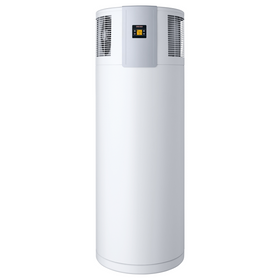
Stiebel Eltron Accelera 300 E Heat Pump Water Heater
Stiebel Eltron
Out of Stock
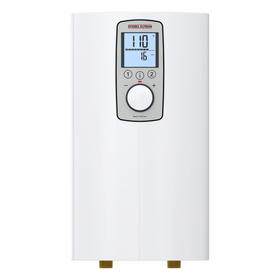
Stiebel Eltron DHC-E 8/10-2 Plus Point-of-Use Electric Tankless Water Heater - 202145
Stiebel Eltron
In Stock
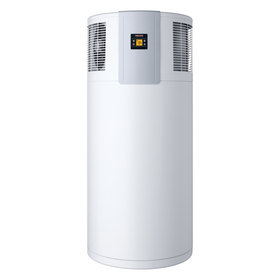
Stiebel Eltron Accelera 220 E Heat Pump Water Heater
Stiebel Eltron
In Stock
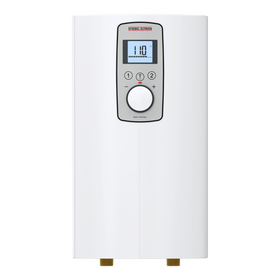
Stiebel Eltron DHC-E 3/3.5-1 Trend Point-of-Use Electric Tankless Water Heater - 200057
Stiebel Eltron
In Stock
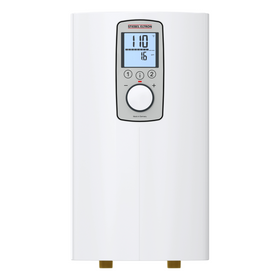
Stiebel Eltron DHC-E 12/15-2 Plus Point-of-Use Electric Tankless Water Heater - 200056
Stiebel Eltron
In Stock
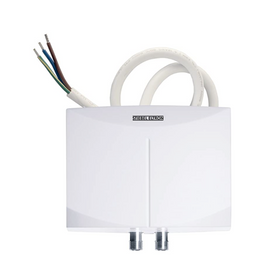
Stiebel Eltron Mini 2-1 Single Handwashing Sink Electric Tankless Water Heater
Stiebel Eltron
In Stock
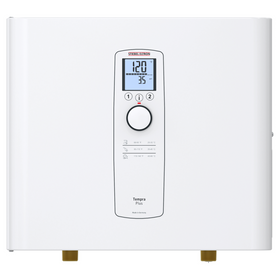
Stiebel Eltron Tempra 24 Whole House 24 kW 5 GPM Electric Tankless Water Heater
Stiebel Eltron
In Stock
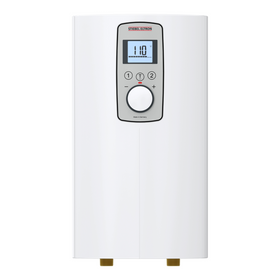
Stiebel Eltron DHC-E 8/10 - 2 Trend Point-of-Use Electric Tankless Water Heater - 200058
Stiebel Eltron
In Stock
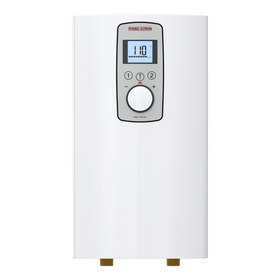
Stiebel Eltron DHC-E 4/6.2 - 2 Trend Point-of-Use Electric Tankless Water Heater - 200061
Stiebel Eltron
In Stock
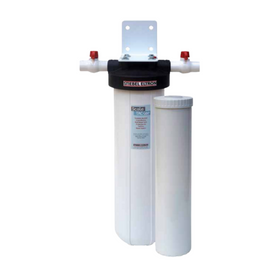
Stiebel Eltron Scale TAC-ler Cartridge
Stiebel Eltron
In Stock
Simple Payback = Upgrade Cost / Annual Savings
Another, more comprehensive, method of calculating payback is by using Net Present Value. Stay tuned - we will dive into this in the future!
When upgrading to a tankless water heater, expensive installation costs can be prohibitive and payback for this retrofit can range in years from 13 to 18, depending on where you live and how much water you use. Some jurisdictions offer rebates on tankless water heaters. If yours does, this could reduce the payback period significantly.
It is important to remember that if your home requires extensive rewiring or changes to plumbing pipework, the added value of manual labor may mean that homeowners lose money over the lifetime of use. In these cases, and from a pure cost-effectiveness standpoint, it might make more economic sense to add extra insulation or install a timer to your existing tank-style water heater.
For new home construction where renovation/installation expenses are not a factor, or for handy homeowners who can handle installation on their own, on-demand water heaters will lead to immediate energy savings and an overall more energy-efficient home.
What Are the Other Benefits of Doing the Upgrade?
Even if expensive installation costs cut into the expected payback period, on-demand water heaters can also help to reduce the carbon footprint of your household. According to the Carbon Fund, which analyzed the EPA's eGRID emission factors, the average US household emits 0.9884 pounds of carbon dioxide for each kWh of electricity used. To see how much CO2 emissions a switch to on-demand heaters can reduce, consider the following equation:
- The average household in the US uses around 909 kWh of electricity each month.
- According to the Department of Energy statistics stated above, 18 percent of that energy (or roughly 164 kWh) is used for water heating each month.
- If homeowners can expect an average of 30 percent savings in energy usage by switching to on-demand water heating, we will be saving about 49 kWh of electricity each month.
- Following the Carbon Fund calculations cited above, switching to on-demand water heating will result in a reduction of at least 48.5 pounds of carbon dioxide being released into the atmosphere each month.
On-demand water heaters offer both economic and environmental benefits and are one way that homeowners can save money while reducing their carbon footprints.
Tobias Roberts
Tobias runs an agroecology farm and a natural building collective in the mountains of El Salvador. He specializes in earthen construction methods and uses permaculture design methods to integrate structures into the sustainability of the landscape.
